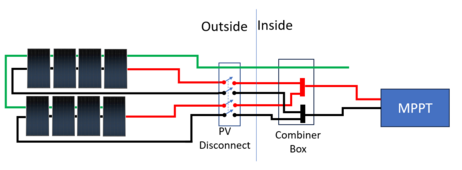The more threads I read the more different ways and opinions there are. So if I could get some expert advise on my particular system I would appreciate it.
8 250W Panels (potentially very cold -10F)
4s2p
Vmp 18.9V
Voc 22.8V X 4 = 91.2 V
Imp 13.2A
Isc 13.7A X1.5 = 27.4A
2 X 4 panel arrays are 30' from entering the house. Once in the house (replacing a 12V system) there is a QO breaker box and the remainder of the run is 30' to the MPPT. The in house wire already is 1/0 and I would like to re-use this so that I don't need to pull new wire.
I am thinking of using 10awg to enter house and combining these arrays in this "combiner" box, before running on the 1/0 to the MPPT.
The box is presently a Square D QO. Can I put a SQ D 50amp (27.4X2) double pole breaker in here as a disconnect? I understand they are rated to 48V DC nominal but my voltage is much higher than this so I am thinking this is a bad idea as a disconnect?
So I am looking at using a Midnight Combiner box, MNPV6 150V , with two double pole 30amp breakers MNEPV30-600-2pp , so both arrays can be disconnected separately.
Panels need a 20amp fuse, "Max Series". Should this fuse be at the panels or can it be 30' later at the combiner box? I am thinking it doesn't matter? And if each 4 panel array has its own breaker do I still need these fuses?
Thanks for your suggestions or advice.
8 250W Panels (potentially very cold -10F)
4s2p
Vmp 18.9V
Voc 22.8V X 4 = 91.2 V
Imp 13.2A
Isc 13.7A X1.5 = 27.4A
2 X 4 panel arrays are 30' from entering the house. Once in the house (replacing a 12V system) there is a QO breaker box and the remainder of the run is 30' to the MPPT. The in house wire already is 1/0 and I would like to re-use this so that I don't need to pull new wire.
I am thinking of using 10awg to enter house and combining these arrays in this "combiner" box, before running on the 1/0 to the MPPT.
The box is presently a Square D QO. Can I put a SQ D 50amp (27.4X2) double pole breaker in here as a disconnect? I understand they are rated to 48V DC nominal but my voltage is much higher than this so I am thinking this is a bad idea as a disconnect?
So I am looking at using a Midnight Combiner box, MNPV6 150V , with two double pole 30amp breakers MNEPV30-600-2pp , so both arrays can be disconnected separately.
Panels need a 20amp fuse, "Max Series". Should this fuse be at the panels or can it be 30' later at the combiner box? I am thinking it doesn't matter? And if each 4 panel array has its own breaker do I still need these fuses?
Thanks for your suggestions or advice.





.png)
